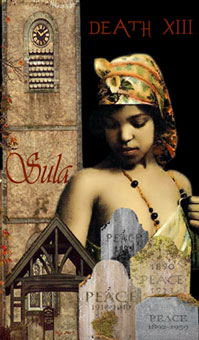XIII Death
Michele Jackson
Sula
The Death Card represents an ending that results in change. It is not usually a physical death, though
it can be. More often it marks a transition from one chapter in our lives to another. I chose the book
Sula, by Toni Morrison, because it describes death on many different levels. Like all of her novels,
there is physical death of various characters. But Sula is not just about the characters, it is also
about the town they lived in and how Sula Peace’s presence and absence affected individuals and the town
as a whole. The town is full of colorful characters and has the distinction of celebrating National
Suicide Day. This holiday, celebrated January third each year, was started by a shell-shocked war
veteran to help him deal with his feelings about death. “In sorting it all out, he hit on the notion
that if one day a year were devoted to it, everybody could get it out of the way and the rest of the
year would be safe and free.” Sula originally left the town to go to college. She is gone for ten years
and when she returns her behavior so scandalizes the town that it affects the townspeople’s behavior.
She quickly puts her grandmother in an old folks home – something virtually unheard of in the African
American community. She sleeps with the husbands of the women she grew up with. The townspeople who
previously had shown no inclination to do so “… began to cherish their husbands and wives, protect their
children, repair their houses and in general band together against the devil in their midst.” Her
departure creates change as well. The entire novel is set against the backdrop of the civil rights
movement, which creates another transition for the town.
The image shows Sula against the background of the local church and cemetery with her family’s
headstones. “Together they read like a chant: PEACE 1895-1921, PEACE 1890-1923, PEACE 1910-1940,
PEACE 1892-1959.”
